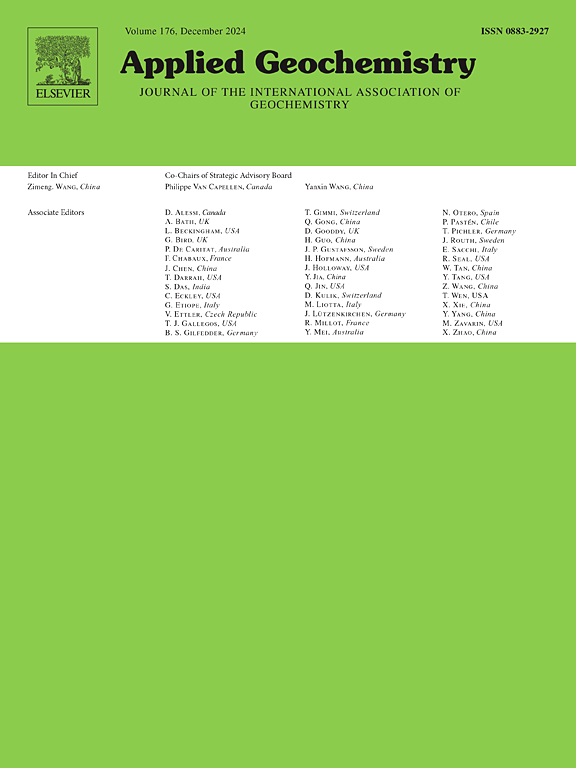Biogeochemical cycle of radium: Insights into alkaline-earth cations budget and evidence of hidden vegetation uptake
IF 3.4
3区 地球科学
Q1 GEOCHEMISTRY & GEOPHYSICS
引用次数: 0
Abstract
The migration of radionuclides in the environment represents a major current issue, especially radium (Ra) that hold one of the main radiation exposure hazards among Naturally Occurring Radioactive Materials. This study aims to assess the biogeochemical radium cycling within a forested ecosystem and to highlight the relevance of Ra isotopes for understanding calcium and other alkaline earth cations behavior. This study was carried out at the INRAE-Andra experimental beech-forested site of Montiers (Meuse, France). 226Ra and 228Ra concentrations were measured in various compartments of the ecosystem: soil solutions, vegetation and soil samples. In-situ experiment of litter decomposition was also performed.
Variations in the 228Ra/226Ra isotopic ratio across ecosystem compartments allowed to distinguish between 228Ra-rich weathering inputs and 228Ra-poor biological return fluxes, thereby enabling to trace the radium cycle. Radium exported by soil solutions predominantly originates from litter decomposition which begins releasing radium only 12–18 months after litterfall. Conversely, the (228Ra/226Ra) ratio in fine roots implied that trees absorbed Ra primarily from mineral soil weathering rather than from litter-derived sources. As a result, approximately 95 % of litter-derived Ra remains in the soil rather than being reabsorbed by vegetation, challenging traditional assumptions of significant reabsorption in cation budget models.
Flux calculations showed vegetation uptake and return fluxes dominate over drainage or atmospheric inputs fluxes. (228Ra/232Th) radioactive disequilibrium within the soil enabled estimation of Ra leaching flux and subsequent vegetation uptake. Results revealed that 7–23 % of the absorbed Ra is incorporated into annual, non-perennial biomass, while 12–43 % is allocated to new biomass increments. Consequently, 34–80 % of the Ra absorbed by vegetation appears to accumulate in unexpected, presumably long-lived, perennial tree structures such as sapwood. These results imply sustained accumulation over multiple years in perennial tissues. While this immobilization of Ra within beech trees may not be generalizable to all tree species, it highlights the need for specific species of detailed analyses across all tree compartments - including radial variations in sapwood - to avoid underestimating vegetation uptake, particularly for alkaline-earth cations such as calcium.

镭的生物地球化学循环:碱土阳离子收支的洞察和隐藏植被吸收的证据
放射性核素在环境中的迁移是当前的一个主要问题,特别是镭(Ra),它是自然发生的放射性物质中主要的辐射暴露危害之一。本研究旨在评估森林生态系统中镭的生物地球化学循环,并强调Ra同位素与理解钙和其他碱土阳离子行为的相关性。这项研究是在法国默兹的Montiers的INRAE-Andra实验山毛榉森林进行的。226Ra和228Ra的浓度被测量在生态系统的各个隔间:土壤溶液,植被和土壤样品。同时进行了凋落物分解的现场实验。228Ra/226Ra同位素比值在生态系统各区间的变化使我们能够区分228Ra富的风化输入和228Ra穷的生物返回通量,从而能够追踪镭循环。土壤溶液输出的镭主要来自凋落物分解,凋落物分解后12-18个月才开始释放镭。相反,细根中的(228Ra/226Ra)比值表明树木主要从矿物土壤风化吸收Ra,而不是从凋落物来源吸收Ra。因此,大约95%的凋落物来源的Ra留在土壤中,而不是被植被重新吸收,这挑战了阳离子预算模型中大量重吸收的传统假设。通量计算表明,植被吸收和返回通量比排水或大气输入通量占主导地位。(228Ra/232Th)土壤中的放射性不平衡使估算Ra淋滤通量和随后的植被吸收成为可能。结果表明,7 - 23%的吸收量被吸收到一年生、非多年生生物量中,而12 - 43%被分配到新增加的生物量中。因此,植被吸收的Ra的34 - 80%似乎积聚在意想不到的,可能是长寿的多年生树木结构中,如边材。这些结果表明在多年生组织中持续积累多年。虽然这种固定在山毛榉树中的Ra可能不能推广到所有树种,但它强调了对所有树室中特定物种进行详细分析的必要性-包括边材的径向变化-以避免低估植被的吸收,特别是对碱土阳离子(如钙)的吸收。
本文章由计算机程序翻译,如有差异,请以英文原文为准。
求助全文
约1分钟内获得全文
求助全文
来源期刊

Applied Geochemistry
地学-地球化学与地球物理
CiteScore
6.10
自引率
8.80%
发文量
272
审稿时长
65 days
期刊介绍:
Applied Geochemistry is an international journal devoted to publication of original research papers, rapid research communications and selected review papers in geochemistry and urban geochemistry which have some practical application to an aspect of human endeavour, such as the preservation of the environment, health, waste disposal and the search for resources. Papers on applications of inorganic, organic and isotope geochemistry and geochemical processes are therefore welcome provided they meet the main criterion. Spatial and temporal monitoring case studies are only of interest to our international readership if they present new ideas of broad application.
Topics covered include: (1) Environmental geochemistry (including natural and anthropogenic aspects, and protection and remediation strategies); (2) Hydrogeochemistry (surface and groundwater); (3) Medical (urban) geochemistry; (4) The search for energy resources (in particular unconventional oil and gas or emerging metal resources); (5) Energy exploitation (in particular geothermal energy and CCS); (6) Upgrading of energy and mineral resources where there is a direct geochemical application; and (7) Waste disposal, including nuclear waste disposal.
 求助内容:
求助内容: 应助结果提醒方式:
应助结果提醒方式:


